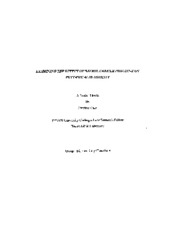| dc.contributor.advisor | Schroeder, FriedheIm | |
| dc.creator | Chen, Cynthia | |
| dc.date.accessioned | 2013-02-22T20:41:07Z | |
| dc.date.available | 2013-02-22T20:41:07Z | |
| dc.date.issued | 1998 | |
| dc.identifier.uri | https://hdl.handle.net/1969.1/ETD-TAMU-1998-Fellows-Thesis-C445 | |
| dc.description | Digitized from print original stored in HDR. Due to the character of the original source materials and the nature of batch digitization, quality control issues may be present in this document. Please report any quality issues you encounter to digital@library.tamu.edu, referencing the URI of the item. | en |
| dc.description | Includes bibliographical references: leaves 19-20. | en |
| dc.description | Program year: 1997/1998 | en |
| dc.description.abstract | Although peroxisomes are essential organelles involved in the conversion of hydrogen peroxide to water, they also contain unique metabolic pathways in lipid metabolism. One of these is the "-oxidation of branched-chain fatty acids such as phytanic acid. Phytanic acid accumulates to toxic levels in patients with defective or deficient numbers of peroxisomes, but little is known about how phytanic acid is taken up into the cell and incorporated into the peroxisome. Sterol carrier protein-2 (SCP-2), a lipid-binding protein concentrated in peroxisomes, may function in phytanic acid uptake and metabolism Fluorescence techniques have shown that SCP-2 can bind phytanic acid, but it is not know whether SCP-2 enhances uptake and/or metabolism of phytanic acid in intact cells. SCP-2 is concentrated in the peroxisomes, but significant amounts are also on the mitochodria and cytosol. To examine SCP-2 function and location of function, transfected L cells over-expressing SCP-2 were exposed to a phytanic acid-albumin complex or to a palmitic acid-albumin complex, and their relative toxicities were compared. The data show that SCP-2 enhanced the toxicity of phytanic acid, which undergoes "-oxidation, but no that of palmitic acid, which undergoes normal $-oxidation in the mitochodria. However, further study is needed to resolve the mechanism whereby SCP-2 mediates the toxicity of phytanic acid. | en |
| dc.format.extent | 37 pages | en |
| dc.format.medium | electronic | en |
| dc.format.mimetype | application/pdf | |
| dc.language.iso | en_US | |
| dc.rights | This thesis was part of a retrospective digitization project authorized by the Texas A&M University Libraries in 2008. Copyright remains vested with the author(s). It is the user's responsibility to secure permission from the copyright holder(s) for re-use of the work beyond the provision of Fair Use. | en |
| dc.subject | peroxisome | en |
| dc.subject | sterol carrier protein-2 | en |
| dc.subject | phytanic acid | en |
| dc.subject | fatty-acid complex | en |
| dc.subject | flow cytometry | en |
| dc.subject | α-oxidation | en |
| dc.subject | β-oxidation | en |
| dc.subject | toxicity | en |
| dc.subject | uptake | en |
| dc.subject | transfected L cells | en |
| dc.subject | SCP-2 over-expressors | en |
| dc.title | Examining the effect of sterol carrier protein-2 on phytanic acid toxicity | en |
| dc.type | Thesis | en |
| thesis.degree.department | Biochemistry | en |
| thesis.degree.department | Chemistry | en |
| thesis.degree.grantor | University Undergraduate Research Fellow | en |
| thesis.degree.name | Fellows Thesis | en |
| thesis.degree.level | Undergraduate | en |
| dc.type.material | text | en |
| dc.format.digitalOrigin | reformatted digital | en |


